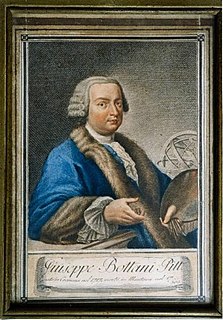Giorgio Picchi il Giovane (active 1586-1599) was an Italian painter active in Rome, Cremona, Rimini, Urbino, and Urbania. He was either a pupil or follower of Federico Barocci. [1]

Italy, officially the Italian Republic, is a European country consisting of a peninsula delimited by the Alps and surrounded by several islands. Italy is located in Southern Europe, and it is sometimes considered as part of Western Europe. The country covers a total area of 301,340 km2 (116,350 sq mi) and shares land borders with France, Switzerland, Austria, Slovenia, and the enclaved microstates of Vatican City and San Marino. Italy has a territorial exclave in Switzerland (Campione) and a maritime exclave in the Tunisian Sea (Lampedusa). With around 60 million inhabitants, Italy is the fourth-most populous member state of the European Union.

Rome is the capital city and a special comune of Italy. Rome also serves as the capital of the Lazio region. With 2,872,800 residents in 1,285 km2 (496.1 sq mi), it is also the country's most populated comune. It is the fourth most populous city in the European Union by population within city limits. It is the centre of the Metropolitan City of Rome, which has a population of 4,355,725 residents, thus making it the most populous metropolitan city in Italy. Rome is located in the central-western portion of the Italian Peninsula, within Lazio (Latium), along the shores of the Tiber. The Vatican City is an independent country inside the city boundaries of Rome, the only existing example of a country within a city: for this reason Rome has been often defined as capital of two states.

Cremona is a city and comune in northern Italy, situated in Lombardy, on the left bank of the Po River in the middle of the Pianura Padana. It is the capital of the province of Cremona and the seat of the local city and province governments. The city of Cremona is especially noted for its musical history and traditions, including some of the earliest and most renowned luthiers, such as Giuseppe Guarneri, Antonio Stradivari, Francesco Rugeri, Vincenzo Rugeri, and several members of the Amati family.
Born in Castel Durante, present-day Urbania, he trained with his father (Giogio Picchi il Vecchio), a profitable maiolica painter and producer. Along with Sebastiano Sabatini, called il Mafori, Picchi il Vecchio was active in Castel Durante and left his active factory of maiolica to his son. [2]

Urbania is a comune (municipality) in the Province of Pesaro e Urbino in the Italian region of Marche, located about 80 kilometres (50 mi) west of Ancona and about 40 kilometres (25 mi) southwest of Pesaro, next to the river Metauro.

Maiolica is tin-glazed pottery decorated in colours on a white background. Italian maiolica dating from the Renaissance period is the most renowned. When depicting historical and mythical scenes, these works were known as istoriato wares. By the late 15th century, several places, mainly small cities in northern and central Italy, were producing sophisticated pieces for a luxury market in Italy and beyond. In France maiolica developed as faience, in the Netherlands and England as delftware, and in Mexico as talavera. In English the spelling was anglicised to "majolica" but the pronunciation remained usually the same with the long "i" as in 'kite'.
His son, however, soon pursued painting on canvas and fresco. He was one of the team of painters employed to paint the Scala Santa, the palace of San Giovanni Laterano, and the Vatican Library in Rome. He painted for the chapel of the Santissimo Sacramento in Cremona. In Rimini, he painted for the church of San Martino and Sant'Agostino. He painted in the no longer extant cloister of the Franciscans in Urbania; a number of his canvases (1586) for the adjacent church of San Francesco still are in place. He died around the age of 50. [3]

Sant'Agostino is a Romanesque-Gothic-style Roman Catholic church located in Via Cairoli #14, in Rimini, Italy. It is one of the older extant church buildings in Rimini.
San Francesco is a Roman Catholic church in Urbania, region of Marche, Italy. It has a diverse set of styles reflecting refurbishments over the centuries.









